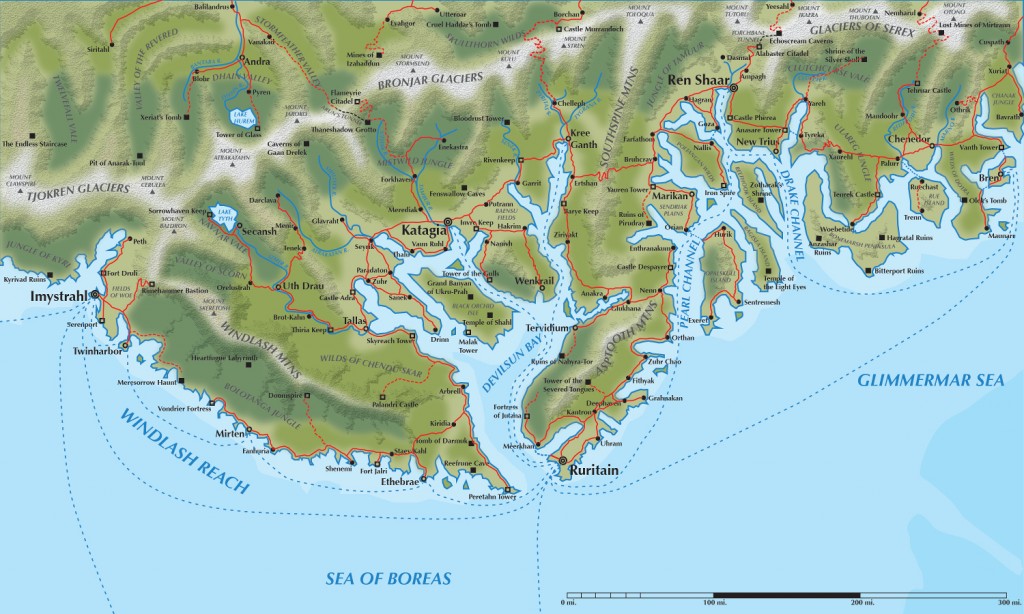Every fantasy setting has its own basic conceit about where and when it exists in the multiverse of possibility. Krynn and Athas are simply other worlds. Toril is another world, but one that long ago was tenuously linked to our own Earth through magical gates (or similar contrivances) in such a way that the fantastic creatures and magic of the Forgotten Realms provided us with many of our own legends of these things. Tolkien’s Middle Earth and Robert E. Howard’s Hyboria are simply “Earth of long ago,” a time many millennia before the dawn of recorded history in which now-lost lands and kingdoms existed. This is the conceit that the Primeval Thule setting shares: Thule once existed on Earth, but now is lost.
If Thule is part of a forgotten history of our world, then the question naturally follows: When did Thule exist, and where was it? Losing continents is not easy, after all. The name “Thule” offers a hint: To the ancient Greeks, Thule was a mysterious land far to the north. Mix in a little of the fun pseudo-science speculation about polar shifts or earth crust displacement with weird anomalies like frozen mammoths found with buttercups in their stomachs, and you can just begin to imagine that maybe the vast lands of the Arctic were temperate and inhabited by human civilizations during the interglacial periods of the Ice Age. Clark Ashton Smith’s Hyperborea was very specifically set in Greenland and other mysterious lands now ice-covered in the Arctic. And Greenland’s immense ice caps would have very effectively erased all evidence of any lost age of human history. So, if you care about this sort of thing: Primeval Thule is Greenland before the last great glacial episode, about 25,000 years ago.
You may be thinking, “Greenland? Seriously?” But bear with us for a moment. Greenland is a very good size for a campaign setting—in fact, it’s about 2000 miles by 600 miles, which makes it about the size of Western Europe or one-third the size of the continental US. Compared to other RPG worlds, that’s about twenty times larger than the Tablelands region of Athas where the Dark Sun setting took place, but not anywhere near as sprawling as oversized continents such as Faerûn or Golarion. Its hidden topography under the ice is quite interesting; there are 10,000-foot mountains, inland seas, and coastlines carved into thousands of islets and fjords by its glacial past. There’s even some speculation about volcanoes buried under the ice.
And, of course, Thule is a fantastic and admittedly ahistoric version of Greenland. In this conception of the lost land of the north, Thule is not at the north pole, although it is a northerly land. Warmed by sea currents and its volcanism, it’s a land of dense forests and impenetrable swamps, crowned by majestic mountains that plunge to the sea in spectacular coastlines. The ice is advancing southward decade by decade, slowly claiming more and more of Thule’s northern margins, but for now savage tribes still roam the deep forest and wicked city-states still thrive in the ice-free regions. Take a look at the demo map that Dave Noonan put together. This area is actually based on a portion of Greenland’s eastern coastline, a region known as Scoresby Sound (incidentally, the biggest single fjord system in the world). That’s how the Greenland of our world is translated into a vision of a fantastic lost age of humankind.
Is Thule an Ancient Setting?
Sort of. When you tell people they’re playing D&D in an ancient setting, they might think that means a setting like ancient Greece or ancient Egypt. While those can be interesting to historically minded players, a lot of other players might be kind of turned off by that—those settings just don’t feel wide-open enough for a D&D campaign. A better way to think of Thule would be to imagine it as a fantastic setting that came so long before the beginning of history that only the dimmest echoes of Thule’s cultures and lands survived into the “real” ancient world. Thule is “ancient” only to the degree that movies and shows like The Scorpion King, Jason and the Argonauts, 300, Conan the Barbarian, Xena, Spartacus, Troy, or anything about Atlantis are ancient.
To put it another way, Thule is NOT a high medieval setting with knights, castles, and shining armor. It’s a setting with barbarians, arenas, and leather fighting harness. Your character isn’t dressing like she’s heading out to a Ren Faire. Instead, she’s dressing like she’s striding out of a Frank Frazetta painting and into your D&D game. We think that’s pretty awesome!


